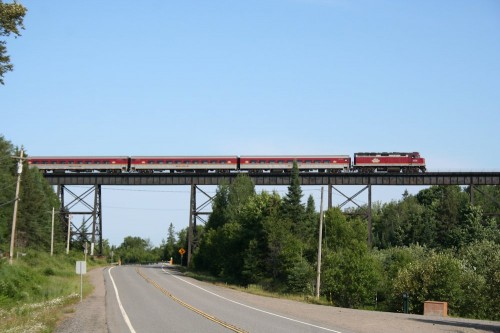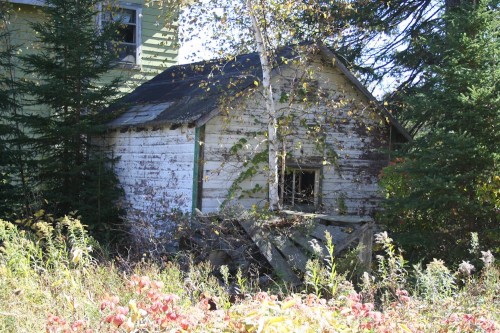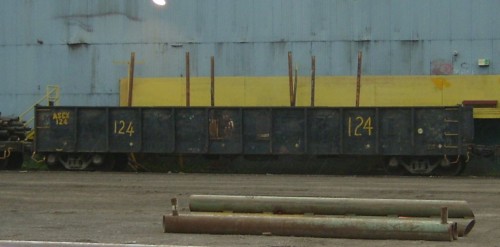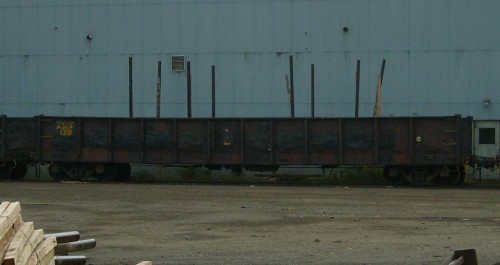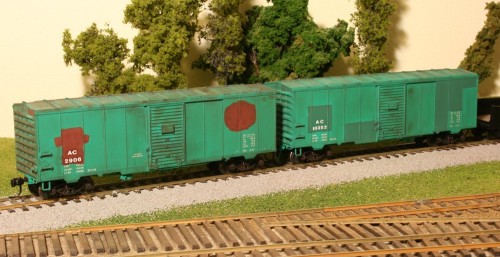Monthly Archives: November 2014
More Small Tool Sheds for the ACR
Here’s another grouping of small tool/materiel storage sheds, following a common ACR pattern. These storage sheds are commonly found with the section houses that dot the line at periodic intervals that once supported track maintenance workers. Below can be seen a classic example with the old section bunkhouse at Franz:
And this similar shed is almost obscured in the weeds and bushes behind Searchmont station, but appears to follow the same pattern and dimensions, although comparing photos of various sheds at different locations, some of the minor details like the position of doors (either centered, or offset to the left or right on the front of the shed) and windows (some on the rear wall as at Searchmont, and other examples showing a small window on one side of the shed) vary a bit from one example to the next.
Nathan Brown of the Searchmont Station Preservation & Historical Society was able to send me the following measured dimensions of the existing shed at Searchmont, which were extremely helpful in laying out the pieces for these sheds. Thanks Nathan for the data!
Hey Chris,
Here are the specs on the shed behind the station.Door: 4ft 10inches from left
2ft 6in opening
window:
4ft 4in from left
5ft 2 in from right
6ft 5in from the peak
3ft 5in from ground
2ft 8 1/2 in opening
shed size is 14 f 3.5 in x 12ft 4.5 inches
Armed with a collection of different photos of various section locations, and particularly of Perry, Franz, and Mosher, which locations I’ll hopefully include in my future layout, I was able to lay out three similar sheds. I don’t have shots that show all four sides of any of these structures but I do have at least one photo at each location showing the shed or part of the shed to know where the front door was located. Given the lack of photos of the rear and both sides, the small window locations were somewhat freelanced based on positions shown in collected photos of similar sheds at different locations. (Each shed has only one window, and on each of the three models below I located it in a different place, but always following precedents shown in prototype photographs.)
Freight Car Friday #11 – ASCX Gondolas
These three old 48′ gondolas photographed in behind the Algoma Steel tube mill at Sault Ste. Marie/Steelton in August 2004 are former Algoma Central cars originally built in 1947 by National Steel Car in series AC 3501-3850. Most of their original lettering has been obliterated but traces of the bear logo is peeking through on all three cars. The 128 below appears to a late 1950s brown repaint.
40′ ex-ONT Boxcars Progressing
This pair of ex-Ontario Northland boxcars has also been receiving some attention lately, with new stencil reporting marks and numbers applied, and some basic weathering with pan pastels. The weathering still has a ways to go, and they also need a little touch up in some areas yet (like some minor patching in the data and re-weigh information to properly date the cars and vary things up a bit more) and the ladders and end details to be re-installed.
As on the model, the real cars were purchased second-hand from the Ontario Northland and just crudely patched out with AC markings. Both of these cars specifically follow the patch patterns of the prototype numbers they represent.
The 2906 is one of roughly 15 former Ontario Northland boxcars put into a series of general service cars; now when I say this, these cars were still basically non-interchange and captive to the ACR, and mostly commonly used for company materials and local wayfreight deliveries.
The 10352 has a work service number, and was likely a tool or work materials storage car. The real car has a pair of turbine style ventilators on the roof which will also still need to be added at some point.
I also have a couple of brown Ontario Northland cars in the wings which will also soon become another 2900 series car and probably another 10000 series work storage car.
Incidentally, this is the 100th post published to this blog!
Rapido Gondola Renumberings and Alternate Logo
Tonight’s project is working on lettering on a few cars. Since I acquired “more than one” 6-packs of Algoma Central gondolas when Rapido Trains released their new Canadian gondola in AC colours, I have a number of cars with duplicate numbers to change. Also, some later repaints had a simplified version of the bear logo without the railway’s name spelled out in an encircling band around the logo. I have several sets of CDS dry transfers for AC gondolas in my lettering stash, and these sets include both versions of the logo, so I decided that on at least a few cars I will also replace these logos for some visual variety.
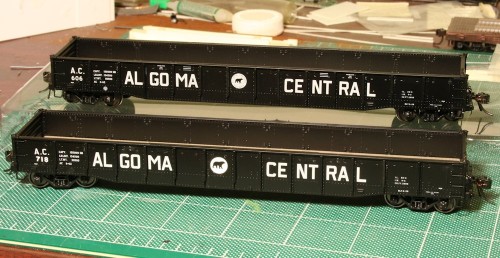
Two Rapido ACR gondolas. Top car is unaltered factory paint/lettering; bottom car is renumbered and has a different logo applied, although differences are more obvious in close up or in person.
To remove the original lettering, I used the edge of a curved scalpel type blade. If you work very carefully, and with a light touch, you can scrape away the original lettering with little trace remaining. The new number and logo will also cover over the same spots, and a little bit of light weathering will completely hide any uneven spots.
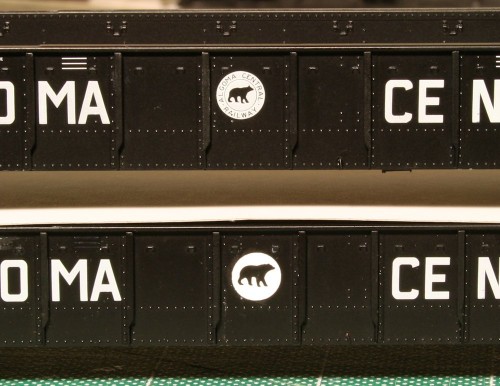
Logo comparison. Above is unaltered factory painted car. Below, the original logo has been carefully removed and replaced with the simplied logo from a CDS dry transfer set.
In the close-up photo you can more clearly see the difference between the logos. The top logo, as featured on the factory-painted Rapido model, includes an outer band around the logo with the railway’s name. The lower logo, applied from a CDS dry transfer lettering set, is a simplified version without the railway name and a proportionally larger bear silhouette.
I also removed the NSC builder’s logo (below the car data) and the fill lines (above the “GO MA” and “NT RA” panels) from the lower car, and I’ll probably actually be going over all of the cars I have and removing the builder’s logo from all of them. (Information suggests that when brand new/as built the original series of cars acquired in 1958 (AC 601-800) were originally painted *brown*, although photos of these cars in original paint are extremely hard to come by. AC 801-875, built in 1961-62 were probably delivered in black, as were coil steel service cars in series AC 900-924, built in 12/1962 and for which I have photos that clearly show the original NSC builders logo. The 900-series also had a slight variation in the font of the billboard lettering…)

